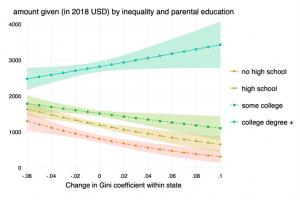
Young adults in the United States are increasingly relying on their parents for economic support. This is due to long-term changes in the labour and housing market that have made it harder for young people to become economically independent after leaving full-time education.
Most parents, at some point, will provide some form of economic support to their young-adult children. However, the type of support that parents provide – and its consequences – depend strongly upon each family’s socio-economic position. Parents from upper-class families (that is, with higher wealth, incomes, and educational attainment) tend to support their children by giving them large sums of money. This helps children achieve financial security and independence early on, for instance by enabling them to make riskier and more rewarding career decisions, or by giving them preferential access to good-quality housing. Parents who are less well-off are instead more likely to help their children by letting them live at home, in what is known as prolonged intergenerational “co-residence.” Co-residence helps children with living expenses, allowing them for example to repay student debt while securing a stable job. The problem, however, is that co-residence is not as beneficial as direct money transfers for the economic outcomes of young adults. While receiving money that can be flexibly spent opens up the employment and housing opportunities of children, living with parents in young adulthood limits the geographic range of job searches, and it can delay the transition into economically independent adulthood. Clearly, social class differences in parental support to young adults are problematic insofar as they represent a way for socio-economic advantage and disadvantage to be transmitted along generational lines.
In the past thirty years, the United States have experienced consistently high or rising levels of income inequality. Sociological theory and research suggest that such inequality can act to exacerbate social class differences in parental support, which does not bode well for social mobility. By definition, rising inequality implies that, in real terms, the rich are getting richer, the poor are getting poorer, or both. As such, inequality enables the rich to give disproportionately more money to their children than the poor. Moreover, inequality can raise the stakes of maintaining a high social status for upper-class families, by making lower social positions much less attractive. In a context of high inequality, upper-class parents may be motivated to give more money to their children to avoid them falling into lower-status occupations and housing, in what is known as “fear of falling” effect. Thus, as inequality increases, those parents who have the resources to do so may intensify their monetary support, enabling children to wait longer for the “right” position to open, or to spend long periods of time in prestigious but unpaid internships. Meanwhile, disadvantaged parents will find it more costly to transfer large sums of money to their children, because the risks associated with financial investments are higher. Instead, they may help children by allowing them to live at home while they secure a stable position. If these or similar mechanisms are at play, then high or rising inequality will make it harder for young adults from disadvantaged backgrounds to achieve independence from the parental home.
In a recent preprint, I study the relationship between income inequality across 50 U.S. states and class gaps in parental transfers of money and co-residence to young adults between 1992 and 2018. I analyse a large sample of families from the Health and Retirement Study, where children are aged 22-35 and parents are aged 50-75 and in good health, so as not to require practical assistance. I link the data on these families’ social class and transfer behaviour to indicators of state-level inequality, unemployment, and housing prices over the same period. I find that, as inequality increases within a given state, wealthier and college-educated parents give more money to their young-adult children (by around £1,000 per year for 0.1-point increase in the Gini coefficient for income inequality, see Figure 1). By contrast, poorer and lower-educated parents are less likely to give money, and more likely to provide co-residence in times of higher inequality. These changes are not explained by other state-level trends such as the spike in housing prices, giving support to the idea that they are brought about by contextual levels of inequality. The data show that upper-class families mainly intensified their money transfers in the years immediately after the Great Recession (2009-2014), as if shielding their children from the crisis. By contrast, the relationship between inequality and the shift from money to co-residence among lower-class families holds for the whole period under study (1992-2018).
Decades of high inequality and the increasing difficulties faced by young adults in the labour and housing markets in the United States make poor prospects for social mobility. My findings are suggestive of a “vicious cycle” by which inequality increases socio-economic disparities in parental transfers and, in turn, the widening disparities in transfers exacerbate inequalities in outcomes in the children’s generation. These problems are difficult to tackle from a policy perspective, because is not possible to force parents to withhold support to their children. The focus should be on equalising access to higher education, labour and housing markets instead.
Ginevra Floridi is a Lecturer in Sociology and Quantitative Methods at the University of Edinburgh. She is also affiliated with Nuffield College and the Leverhulme Centre for Demographic Science at the University of Oxford. Her research focuses on contextual influences on individual and family behaviours including intergenerational transfers, fertility, and the provision of care. Follow her @ginevra_floridi
Figure 1. Change in inequality within a state and predicted amount of money given to children by parents’ educational attainment

Linked references
Fingerman, K., Kim, K., Davis, E. M., Furstenberg Jr., F. F., Birditt, K. S., & Zarit, S. H. (2015). “I’ll Give You the World”: Socioeconomic Differences in Parental Support of Adult Children. Journal of Marriage and Family, 77, 844–865. https://doi.org/10.1111/jomf.12204
Floridi, G. (2023). Inequality and class divides in parental transfers to young adults in the United States. https://doi.org/10.31235/osf.io/g8yv2
Manzoni, A. (2018). Parental Support and Youth Occupational Attainment: Help or Hindrance? Journal of Youth and Adolescence, 47, 1580–1594. https://doi.org/10.1007/s10964-018-0856- z
Mitnik, P. A., Cumberworth, E., & Grusky, D. B. (2016). Social Mobility in a High-Inequality Regime. The ANNALS of the American Academy of Political and Social Science, 663, 140– 184. https://doi.org/10.1177/0002716215596971
Schneider, D., Hastings, O. P., & LaBriola, J. (2018). Income Inequality and Class Divides in Parental Investments. American Sociological Review, 83, 475–507. https://doi.org/10.1177/0003122418772034
Sironi, M., & Furstenberg, F. F. (2012). Trends in the Economic Independence of Young Adults in the United States: 1973–2007. Population and Development Review, 38, 609–630. https://doi.org/10.1111/j.1728-4457.2012.00529.x
Toft, M., & Friedman, S. (2021). Family Wealth and the Class Ceiling: The Propulsive Power of The Bank of Mum and Dad. Sociology, 55, 90–109. https://doi.org/10.1177/003803852092253

Comments